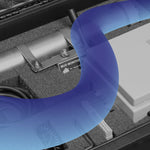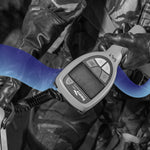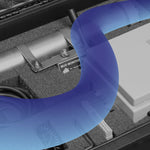How to select the right radiation monitor for your requirements
- by Madelyn Stoddart
-

Radiation monitoring is crucial for maintaining safety in industries like first responders including fire fighters and police, oil and gas, nuclear energy, military and environmental management.
With various radiation monitors available, finding the one that best suits your needs can be overwhelming. This guide will walk you through the essential factors to consider and introduce you to Tracerco’s reliable range of radiation monitors.
1. Key factors to consider when choosing a radiation monitor
Selecting the right radiation monitor depends on several variables. Here are the critical factors to keep in mind:
- Type of radiation detected: Ensure the monitor can measure the specific radiation type relevant to your application, such as alpha, beta, gamma, or neutron radiation.
- Sensitivity and accuracy: Look for devices with high precision to ensure accurate readings, especially in sensitive environments.
- Portability: In industries like oil and gas, having a lightweight, portable radiation monitor is essential for on-the-go measurements.
- Durability and environmental resistance: If you work in harsh conditions, choose a monitor that is water-resistant, shockproof, and capable of operating under extreme temperatures.
- Ease of use: Opt for devices with user-friendly interfaces, clear displays, and minimal calibration requirements.
2. Common applications of radiation monitors
Radiation monitors are indispensable tools across various industries. Some common applications include:
- Oil and gas: In the oil and gas industry, radiation monitoring is essential for ensuring safety during exploration, drilling, production, and decommissioning. One of the primary concerns is the presence of naturally occurring radioactive materials (NORM), which can accumulate in pipelines, production equipment, and storage tanks, posing potential health risks to workers and requiring proper management to comply with safety regulations. Additionally, personal dose monitoring is critical for workers who may be exposed to radiation in offshore and onshore operations, ensuring their exposure remains within safe limits. Another key application is Logging While Drilling (LWD), where radiation detection tools are integrated into the drilling process to measure formation properties in real time. This helps optimise drilling performance, assess reservoir conditions, and identify potential radiation hazards deep underground. By using specialised radiation monitors, companies can proactively mitigate risks, ensure regulatory compliance, and protect both personnel and the environment from radiation hazards associated with oil and gas operations.
- Nuclear energy: Monitoring radiation exposure to protect workers and ensure compliance with safety standards.
- Environmental monitoring: Detecting and measuring radiation levels in air, water, and soil.
- Medical Facilities: Ensuring safe radiation levels in diagnostic and therapeutic applications.
- CBRNe responders: Radiation monitors to detect radiological hazards and closely track exposure during emergency response situations.
- CBRNe responders (Chemical, Biological, Radiological, Nuclear, and Explosives): Emergency responders—including firefighters, police, and military personnel—require specialised radiation monitors to detect radiological hazards during emergency situations, terrorist threats, or industrial accidents. These devices help responders assess risk levels and ensure proper protective measures are taken.
- Military & Defence: Armed forces and defence agencies utilise radiation detection technology for nuclear threat assessment, battlefield safety, and radiation exposure monitoring. Portable radiation monitors assist in evaluating nuclear contamination risks and maintaining the safety of personnel in conflict zones or hazardous environments.
- Industrial & Workplace Safety: Beyond nuclear and oil industries, radiation monitoring is essential in manufacturing, construction, and waste management, where radioactive materials may be present in certain industrial processes. Real-time radiation detection helps mitigate exposure risks and maintain occupational safety standards.
3. Why choose Tracerco radiation monitors?
Tracerco’s range of radiation monitors offers a combination of advanced technology, reliability, and ease of use. Here’s what sets them apart:
- Precision engineering: Our monitors deliver accurate, real-time measurements in challenging environments.
- Portability: Lightweight designs ensure easy transport and usability.
- Versatile applications: Suitable for use in a variety of industries, from oil and gas to environmental monitoring.
- Long battery life: Operate longer in the field without frequent recharges.
- Durability: Engineered to withstand rugged industrial conditions, our monitors are built to last.
Popular models include the Tracerco T402 Radiation Monitor, known for its reliability and ease of operation, and the Tracerco NORM Monitor, designed for detecting low-level radioactive materials.
4. Steps to purchase the right radiation monitor
Finding the perfect radiation monitor for your needs is simple with Tracerco:
- Identify Your Requirements: Define the type of radiation and the environment where the monitor will be used.
- Explore Our Range: Browse Tracerco’s monitors to find models suited to your application.
- Contact Our Experts: Our team is here to help. Reach out for guidance or product recommendations.
- Order Online: Place your order directly on our website or contact us for a customised quote.
Choosing the right radiation monitor is essential for ensuring safety and compliance in any industrial setting. By considering your specific needs and exploring Tracerco’s range of reliable monitors, you can confidently find the perfect solution. Visit our store or contact our team today to get started.
Ready to find your ideal radiation monitor?
Browse our products or Contact us for expert advice!






